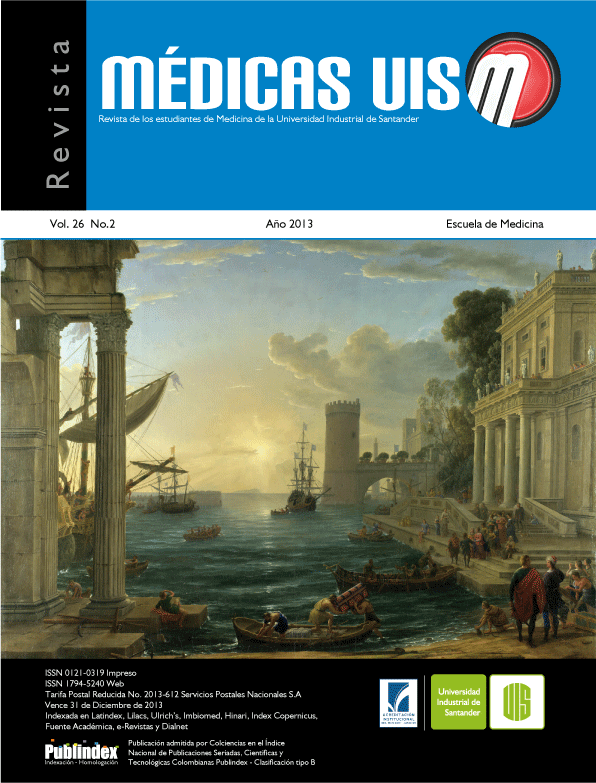Abstract
Introduction: hepatitis B is a global health problem due to its high magnitude and diversity of factors and risk groups. Medical students are one of the main risk groups because of their frequency of unsafe sex and low adherence to biosecurity standards. Objective: to assess
the knowledge, attitudes and practices about hepatitis B and its association with demographic,socio-economic and academic aspects, in medical students of Medellin. Materials and Methods: cross sectional study in 235 students of a medical school in Medellin, selected using stratifed probability sampling with proportional allocation. We used primary source of information and we created a scale with 60 points. The description was made with summary measures, frequencies and confdence interval; the identifcation of factors associated
with knowledge, attitudes and practices with U Mann Whitney, one-way ANOVA, Tukey, Rho Spearman, according to the fulfllment or not of normality assumption, and linear regressions in SPSS 20. Results: the knowledge, attitudes and practices were unsatisfactory in a high
proportion of students, only 43% recognize Hepatitis B virus infection as hazardous to health personnel, 77% know the vaccination schedule and less than 90% identifed the groups and transmission routes of most risk. The knowledge, attitudes and practices showed statistical
association with age and semester; we showed that the practices related to HBV presented positive correlation with the knowledge and attitudes. Conclusion: the knowledge, attitudes and practices were unsatisfactory and the main risk group are the students of basic cycle.
This presented are useful for the development of cost-efective strategies for reducing the risk of infection by the hepatitis B virus in risk groups such as health students and the general population. (MÉD.UIS. 2013;26(2):9-20).
References
2. Asociación Española de Pediatría [sede Web]. España: Asociación Española de Pediatría; 2012 [acceso 28 de mayo 2011]. Hepatitis B. [179 páginas] Disponible en: http://www.aeped.es/sites/default/files/documentos/enfermedades_prevenibles_vacunaciones.pdf
3. Departamento Administrativo Distrital de Salud [sede Web]. Colombia: Instituto Nacional de Salud de Colombia; 2000 [Acceso 20 de junio 2011]. Protocolo de vigilancia de Hepatitis B. Disponible en: http://www.dadiscartagena.gov.co/web/images/docs/saludpublica/HepatitisB-f.pdf
4. Zamani F, Fallahian F, Hashemi F, Shamsaei Z, Alavian S. Immune response to hepatitis B vaccine in health-care workers. Saudi J Kidney DisTranspl. 2011;22(1):179-84.
5. Hincapié A, Domínguez M, Garcés C. Conocimientos y presencia de hepatitis B en los estudiantes de pregrado de la Facultad de Odontología de la Universidad de Antioquia en el año 2003. Rev Fac Odontol Univ Antioq. 2004;15(2):28-38.
6. Cabrera G. Teorías y modelos en Salud Pública. Medellín: Universidad de Antioquia; 2007.
7. Abad J, Madrigal A, Mestre F. El SIDA como enfermedad social: análisis de su presencia e investigación. Cuad. trab. soc. 2005;18:33-55.
8. Vildózola H, Salinas J. Historia natural de la infección crónica por el virus hepatitis B. Rev. Gastroenterol. Perú. 2009;29(2):147-57.
9. Organización Panamericana de la Salud. Reunión regional sobre hepatitis virales. Bogotá, Colombia:OMS; Marzo 1 y 2 del 2012. [Acceso 20 de junio 2012]. Disponible en: http://new.paho.org/hq/index.php?option=com_docman&task=doc_view&gid=18288&Itemid=
10. Yuste H, Valcárcel Y, Gil A. Estado vacunal y conocimiento sobre la vacuna de la Hepatitis B en alumnos de Enfermería. NURE Inv. 2006;22:2-17.
11. Moscatelli R, Mazzulla A, Facchini C, Martínez L, Gutiérrez S, Montano A. Índice de cobertura de la vacuna antihepatitis B en una población de riesgo. Arch Pediatr Urug. 2006;77(1):18-23.
12. Díaz L, Cadena L. Riesgo de infección por hepatitis B entre estudiantes de medicina peruanos luego de exposición a sangre y líquidos corporales. Rev. Gastroenterol. Perú. 2003;23(2):107-10.
13. Marocho L, Vildózola H, Valencia E, Romero G, Huamán A, Solano L, et al. Efecto protector de una vacuna recombinante contra la hepatitis B siguiendo tres esquemas de inmunización. Lima - Perú 2004. An. Fac. med. 2006;67(1):5-10.
14. Osorio L, Patiño T, Tagle M, Huayanay L. Percepciones, conocimientos y actitudes sobre enfermedad hepática en adultos sanos que acuden a instituciones de salud de estrato A, B y C. Rev. Gastroenterol. Perú. 2010;30(2):126-32.
15. Sevillano-Suárez E, Espinosa-Desantillana I, Vargas-García H. Nivel de conocimiento sobre el manejo estomatológico de pacientes infectados con el virus de hepatitis en las clínicas del ISSSTEP. Puebla 2006. Rev ADM. 2008;65(4):206-11.
16. Taylor VM, Jackson JC, Pineda M, Pham P, Fischer M, Yasui Y. Hepatitis B knowledge among Vietnamese immigrants: implications for prevention of hepatocellular carcinoma. J Cancer Educ. 2000;15(1):51-5.
17. Taylor VM, Jackson JC, Chan N, Kuniyuki A, Yasui Y. Hepatitis B knowledge and practices among Cambodian American women in Seattle, Washington. J Community Health. 2002;27(3):151-63.
18. Thompson MJ, Taylor VM, Jackson JC, Yasui Y, Kuniyuki A, Tu SP, et al. Hepatitis B knowledge and practices among Chinese American women in Seattle, Washington. J Cancer Educ. 2002;17(4):222-6.
19. Cortijo J, Gómez M, Samalvides F. Cambios en conocimientos, actitudes y aptitudes sobre bioseguridad en estudiantes de los últimos años de Medicina. Rev Med Hered. 2010;21(1):27-31.
20. Rodríguez A, Novalbos JP, Costa MJ, Zafra JA. Accidentalidad e incidencia de accidentes biológicos de riesgo en estudiantes de enfermería. Med Clin (Barc). 2000;115(7):251-3.
21. Tilzey AJ, Banatvala JE. Protection from HIV on electives: questionnaire survey of UK medical schools. BMJ. 2002;325(7371):1010-1.
22. Herrera AC, Gómez R. Accidentes por riesgo biológico en los estudiantes de medicina y médicos internos de la Universidad Tecnológica de Pereira. Rev Med Risaralda. 2003;9(1):1-10.
23. Díaz L, Cadena L. Incidencia y circunstancias de los accidentes biológicos entre los estudiantes de medicina. MedUNAB. 2001;4:173-8.
24. Ramos SB, Castillo C, Reyes N, Villalba VA, Erquinigo N, Villanueva L. Accidentes laborales con exposición a fluidos corporales en internos de Medicina de Lima Metropolitana. CIMEL. 2001;6:26-30.
25. Díaz LA, Cadena LP. Los accidentes biológicos entre estudiantes de medicina: el caso de la UNAB. MedUNAB. 2001;4(12):161-6.
26. Hwang JP, Roundtree AK, Engebretson JC, Suarez-Almazor ME. Medical care of hepatitis B among Asian American populations: perspectives from three provider groups. J Gen Intern Med. 2010;25(3):220-7.
27. Martínez ME. Estrategias de control de las hepatitis B y Delta en Colombia. Acta Med Colomb. 1990;15(6):348-9.
